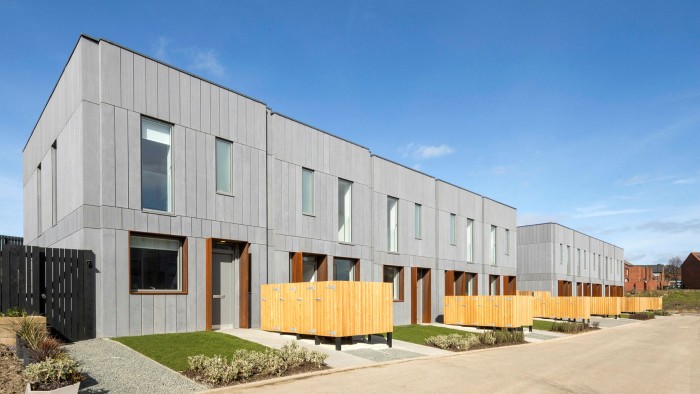
Modular architecture: a new era of building innovation
In recent years, modular architecture has emerged as a groundbreaking concept in the realm of building and construction. This innovative approach employs a system where various standard sections, known as modules, are constructed off-site and then transported to the building site for assembly. The flexibility and efficiency of this type of architecture resonate particularly well with home enthusiasts looking to explore new ways of housing development.
As the world shifts towards sustainable solutions, understanding what modular architecture offers can open up exciting opportunities for modern living. From cost-effectiveness to sustainability, this method is paving the way for the future of construction.

The Benefits of Modular Architecture
1. Efficient Construction
One of the most lauded aspects of modular architecture is the swiftness of the construction process. Building modules off-site significantly reduces the time spent on weather-dependent building activities. According to the National Association of Home Builders, projects can be completed 30-50% faster than traditional construction methods, demonstrating a clear advantage to those looking to expedite home building processes.
2. Cost-Effectiveness
Building with modules can lead to substantial cost savings. Materials are purchased in bulk, and labor costs are minimized due to the streamlined process. This means more budget can be allocated towards the quality and customization of materials used, making it an excellent choice for budget-conscious homeowners.
3. Customization and Flexibility
Another standout feature is the extensive customization options available. Homeowners can modify designs to fit unique needs, whether they want a tiny home or a luxurious mansion. This flexibility allows for personal expression in ways traditional architecture might not.
4. Eco-Friendly Solutions
As sustainable living becomes a priority, modular architecture presents an eco-friendly alternative. The off-site construction process reduces waste and energy usage. Additionally, modules can incorporate energy-efficient materials and technologies, supporting a greener future.
How Modular Architecture Works
5. Design Phase
Designing a modular home starts with planning and customization according to the client’s needs. Architects use cutting-edge software to create detailed designs that ensure all modules fit together seamlessly upon assembly.
6. Off-Site Construction
The modules are constructed in a factory setting, which allows for better quality control and protection from weather-related issues. This controlled environment is key to maintaining consistent quality and standards across all modules.
7. Transportation and Assembly
Once the modules are complete, they are transported to the construction site. Here, they are assembled quickly and efficiently, minimizing the time traditionally spent on-site. The swift assembly process means less disruption to the surrounding area and a faster move-in date.
The Future of Modular Architecture
8. Expanding Architectural Horizons
With advancements in technology and materials, modular architecture continues to evolve, expanding the possibilities for architectural innovation. Architects are exploring creative layouts and cutting-edge materials to push the boundaries of what can be achieved with modules.
9. Urban and Rural Applications
Modular construction suits both urban and rural environments, offering solutions to space constraints and urban density challenges, as well as providing quick and affordable housing in less populated areas.
10. Overcoming Barriers to Adoption
Despite its advantages, modular architecture sometimes faces resistance due to misconceptions about quality and durability. As more successful projects showcase the reliability and aesthetic appeal of modular buildings, these misconceptions will likely be dispelled.
11. Integration with Smart Home Technology
The integration of smart home technologies is another exciting potential for modular homes. With built-in smart systems, homeowners can enjoy increased convenience and improved energy efficiency.
Case Studies and Success Stories
12. Noteworthy Projects Around the World
Successful implementations of modular architecture serve as testaments to its viability and potential. For example, the stunning modular housing units seen in cities worldwide illustrate the adaptability and elegance possible with these methods.
13. Lessons Learned from Modular Projects
Examining lessons learned from renowned modular projects can provide insights into overcoming challenges and optimizing design and construction processes. These lessons are crucial for architects and builders aiming to maximize the benefits of modular methods.
Challenges and Considerations
14. Navigating Regulatory Landscapes
Understanding local regulations is a pivotal step in successful modular construction projects. Navigating these can be complex, yet careful planning and adhering to zoning laws are essential for seamless project execution.
15. Quality Control and Assurance
The emphasis on quality control in manufacturing ensures consistent quality across all modules. Rigorous testing and inspections are in place to guarantee that each unit meets high standards.
Conclusion
Modular architecture stands at the forefront of modern construction and design. As it continues to evolve and adapt to new technologies and sustainable practices, it offers an exciting opportunity for those looking to create their ideal homes efficiently and affordably. It represents not just a trend but a substantial shift towards smarter, more innovative construction.

Frequently Asked Questions
What is Modular Architecture?
Modular architecture involves constructing buildings using pre-fabricated modules that are built off-site and then assembled on location. It offers benefits in terms of cost, time efficiency, and environmental sustainability.
Is Modular Construction More Affordable?
Generally, modular construction can be more cost-effective due to reduced labor costs and economies of scale in purchasing materials. However, final costs depend on design specifications and materials chosen by the homeowner.
Can I Customize a Modular Home?
Yes, one of the significant benefits of modular architecture is its ability to facilitate extensive customization. Homeowners can design their homes to reflect personal tastes and needs, from layout to finishes.
This article contains affiliate links. We may earn a commission at no extra cost to you.